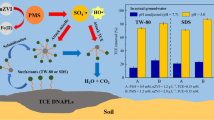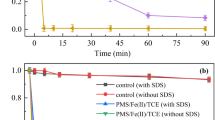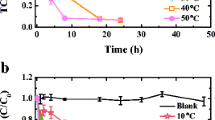Abstract
Dense nonaqueous phase (DNAPL) trichloroethylene (TCE) degradation by potassium permanganate (KMnO4) was investigated in the presence of the cationic surfactant pentyltriphenylphosphonium (PTPP) bromide, acting as a phase transfer catalyst. Series of batch tests were performed in 5.0-mL conical vials containing Milli-Q water and 1.0 mM DNAPL TCE with initial permanganate concentrations ([MnO4 −]0) of 1.0, 2.0, 3.0, and 5.0 mM, adding PTPP (0, 10, and 20 mol% of permanganate, respectively). Chloride ion (Cl−) and MnO4 − in water samples were analyzed to observe MnO4 − consumption and TCE degradation over the elapsed time (0 to 90 min). The calculated values of pseudo first-order rate constants for MnO4 − consumption indicated that the rate of MnO4 − depletion increased with higher mole percent PTPP. At experimental conditions of 1.0 and 2.0 mM [MnO4 −]0, analyses of Cl− concentration showed that higher mole percent of PTPP induced greater Cl− release, indicating faster TCE oxidation. On the other hand, for 3.0 and 5.0 mM [MnO4 −]0, the concentration of Cl− was lower with the presence of PTPP. This result indicated that MnO4 − had migrated further into the inner space of DNAPL, and consequently, the Cl− took a longer time to diffuse from DNAPL to an aqueous phase.





Similar content being viewed by others
References
Aulenta, F., Majone, M., & Tandoi, V. (2006). Enhanced anaerobic bioremediation of chlorinated solvents: environmental factors influencing microbial activity and their relevance under field conditions. J. Chem. Technol. Biotechnol. Rev., 81, 1463–1474.
Choi, K., & Lee, W. (2012). Enhanced degradation of trichloroethylene in nano-scale zero-valent iron Fenton system with Cu(II). Journal of Hazardous Materials, 211–212, 146–153.
Davie, M. G., Cheng, H., Hopkins, G., & Lebron, C. (2008). Implementing heterogeneous catalytic dechlorination technology for remediating TCE-contaminated groundwater. Environmental Science and Technology, 42, 8908–8915.
Destailats, H., Aldersion, T. W., & Hoffmann, M. R. (2001). Applications of ultrasound in NAPL remediation: sonochemical degradation of TCE in aqueous surfactant solutions. Environmental Science and Technology, 35, 3019–3024.
Gates-Anderson, D. D., Siegrist, R. L., & Cline, S. R. (2001). Comparison of potassium permanganate and hydrogen peroxide as chemical oxidants for organically contaminated soils. Journal of Environmental Engineering, 127, 337–347.
Gomes, H. I., Dias-Ferreira, C., & Ribeiro, A. B. (2012). Electrokinetic remediation of organochlorines in soil: enhancement techniques and integration with other remediation technologies. Chemosphere, 87, 1077–1090.
Huang, K. C., Hoag, G. E., Chheda, P., Woody, B. A., & Dobbs, G. M. (1999). Kinetic study of oxidation of trichloroethylene by potassium permanganate. Environmental Engineering Science, 16, 265–274.
Kim, K., & Gurol, M. (2005). Reaction of nonaqueous phase TCE with permanganate. Environmental Science and Technology, 39, 9303–9308.
Kim, Y. S., Jafvert, C. T., Yoon, S., Hyun, S., & Johnson, B. (2009). Potential consolidation-induced NAPL migration from coal tar impacted river sediment under a remedial sand cap. Journal of Hazardous Materials, 162, 1364–1370.
Kim, Y. S., Nyberg, L. M., Jenkinson, B., & Jafvert, C. T. (2013). PAH concentration gradients and fluxes through sand cap test cells installed in situ over river sediments containing coal tar. Environ. Sci Processes Impacts, 15, 1601–1612.
Lee, E. S., Seol, Y., Fang, Y. C., & Schwartz, F. W. (2003). Destruction efficiencies dynamics of reaction fronts associated with the permanganate oxidation of trichloroethylene. Environmental Science and Technology, 37, 2540–2546.
Li, Z. (2004). Surfactant-enhanced oxidation of trichloroethylene by permangnate-proof of concept. Chemosphere, 54, 419–423.
Liang, S. H., Kuo, Y. C., Chen, S. H., Chen, C. Y., & Kao, C. M. (2013). Development of a slow polycolloid-releasing substrate (SPRS) biobarrier to remediate TCE-contaminated aquifers. Journal of Hazardous Materials, 254–255, 107–115.
Liu, Y. Q., Phenrat, T., & Lowry, G. (2007). Effect of TCE concentration and dissolved groundwater solutes on NZVI-promoted TCE dechlorination. Environmental Science and Technology, 41, 7881–7887.
Masten, S. J., & Davies, S. H. R. (1997). Efficacy of in-situ ozonation for the remediation of PAH contaminated soils. Journal of Contaminant Hydrology, 28, 327–335.
Mercer, J. W., & Cohen, R. M. (1990). A review of immiscible fluids in the subsurface: properties, models, characterization and remediation. Journal of Contaminant Hydrology, 6, 107–163.
Pant, P., & Pant, S. (2010). A review: advances in microbial remediation of trichloroethylene (TCE). Journal of Environmental Sciences, 22, 116–126.
Rao, P. S. C., Annable, M. D., & Kim, H. (2000). NAPL source zone characterization and remediation technology performance assessment: recent developments and applications of tracer techniques. Journal of Contaminant Hydrology, 45, 63–78.
Rothmel, R., Peters, R., Martin, E., & Deflaun, M. (1998). Surfactant foam/bioaugmentation technology for in situ treatment of TCE-DNAPLs. Environmental Science and Technology, 32, 1667–1675.
Schnarr, M., Truax, C., Farquhar, G., Hood, E., Gonullu, T., & Stickney, B. (1998). Laboratory and controlled field experiments using potassium permanganate to remediate trichloroethylene and perchloroethylene DNAPLs in porous media. Journal of Contaminant Hydrology, 29, 205–224.
Seol, Y., & Schwartz, F. W. (2000). Phase-transfer catalysis applied to nonaqueous phase trichloroethylene by potassium permanganate. Journal of Contaminant Hydrology, 44, 185–201.
Stroo, H. F., Ward, C. H., Kavanaugh, M. C., Vogel, C., Leeson, A., Marqusee, J. A., & Smith, B. P. (2003). Remediating chlorinated solvent source zones. Environmental Science and Technology, 37, 224–230.
Tobiszewski, M., & Namieśnik, J. (2012). Abiotic degradation of chlorinated ethanes and ethenes in water. Environ. Sci. Pollut. R., 19, 1994–2006.
Waldemer, R. H., Tratnyek, P. G., Johnson, R. L., & Nurmi, J. T. (2007). Oxidation of chlorinated ethenes by heat-activated persulfate: kinetics and products. Environmental Science and Technology, 41, 1010–1015.
Wang, Q., Jeong, S., & Choi, S. (2012). Removal of trichloroethylene DNAPL trapped in porous media using nanoscale zerovalent iron and bimetallic nanoparticles: direct observation and quantification. Journal of Hazardous Materials, 213–214, 299–310.
Wilson, B., Ni, X., & Sherrington, D. C. (2001). On the investigation of a phase-transfer catalysis reaction in an oscillatory baffled reactor. Industrial and Engineering Chemistry Research, 40, 5300–5304.
Yan, Y. E., & Schwartz, F. W. (2000). Kinetics and mechanisms for TCE oxidation by permanganate. Environmental Science and Technology, 34, 2535–2541.
Yeh, C. K., Wu, H. M., & Chen, T. C. (2003). Chemical oxidation of chlorinated non-aqueous phase liquid by hydrogen peroxide in natural sand systems. Journal of Hazardous Materials, 96, 29–51.
Yan, Y. E., & Schwartz, F. W. (1999). Oxidative degradation and kinetics of chlorinated ethylenes by potassium permanganate. Journal of Contaminant Hydrology, 37, 343–365.
Author information
Authors and Affiliations
Corresponding author
Rights and permissions
About this article
Cite this article
Kim, K., Kim, Y.S. & Gurol, M.D. DNAPL TCE Oxidation with Permanganate: Influence of the Phase Transfer Catalyst Pentyltriphenylphosphonium. Water Air Soil Pollut 224, 1735 (2013). https://doi.org/10.1007/s11270-013-1735-6
Received:
Accepted:
Published:
DOI: https://doi.org/10.1007/s11270-013-1735-6




